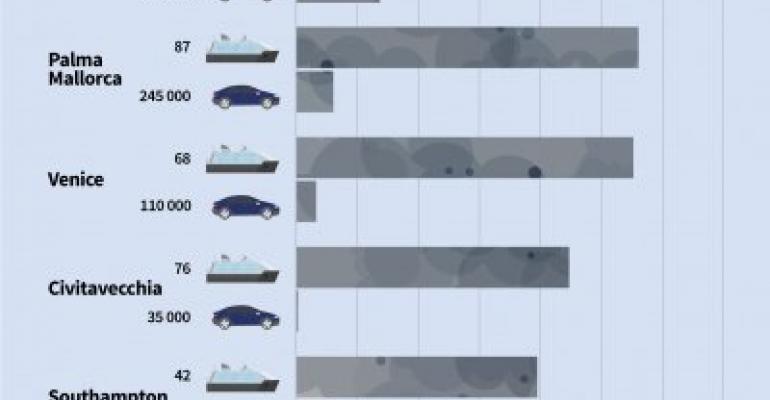Established in 1990, T&E represents 60 organisations from 25 countries across Europe, mostly environmental groups and campaigners working for sustainable transport policies at national, regional and local level.
T&E's report goes on to state, ‘Spain, Italy and Greece, closely followed by France and Norway, are the European countries most exposed to SOx air pollution from cruise vessels while Barcelona, Palma de Mallorca and Venice are the most impacted European port cities, followed by Civitavecchia (Rome) and Southampton.’
Faig Abbasov, shipping policy manager at T&E, said: ‘Luxury cruise ships are floating cities powered by some of the dirtiest fuel possible. Cities are rightly banning dirty diesel cars but they’re giving a free pass to cruise companies that spew out toxic fumes that do immeasurable harm both to those on board and on nearby shores. This is unacceptable.’
CLIA questions report's science
A statement issued by CLIA in Brussels said: 'We welcome the involvement of civil society in this discussion but are disappointed that Transport & Environment have published this internal analysis, conducted by their own staff, without discussion or input from the cruise industry or the destinations we visit.’
CLIA is concerned that its results have been published without any academic scrutiny or peer review. ‘The methodology used to calculate the results has also not been agreed as a scientifically robust process.’
MedCruise, the Association of the Mediterranean Cruise Ports, also strongly refutes the T&E findings, which it says are based on ‘in-house analysis using a methodology with estimated data on cruise ships emissions.’
Developing greener alternatives
CLIA’s statement highlights how the cruise industry has been looking at greener alternatives, citing its early adopting of exhaust gas cleaning (EGCS) technology and LNG propulsion.
‘More than one-third of all new ships being built, [25 ships in total], will use LNG as their primary propulsion fuel. Currently, two ships are equipped to use LNG while in port, reducing emissions in port cities. Over 70% of the cruise fleet – 152 ships – are already dual fuel ships, able to use alternative fuels such as methanol and biodiesel as well as traditional fossil fuels. Some are even able to turn their food waste into fuel,’ noted CLIA.
CLIA highlights how the industry is working to reduce harmful emissions. ‘These percentages for EGCS and LNG are unmatched in any other shipping sector and not fully appreciated in T&E’s analysis.’
T&E called for Europe to implement a zero-emission port standard as soon as possible and recommends extending emission control areas (ECAs), currently in place only in the North and Baltic Seas and English Channel, to the rest of the European seas.
Extending SECAs
Time constraints remain as an issue, claims CLIA: ‘Extending the Sulfur Emission Control Areas (SECA) standards to the rest of EU seas will take time and in accordance with the current regulatory framework, we would appreciate confirmation that both open and closed loop EGCS are allowed to be used, that LNG and other alternative fuels are supported and developed and that they are physically available to be used. For a front runner like the cruise industry, certainty of early investments and predictability of future expectations is of major importance. Of course, any new SECA would have to be proposed following the worldwide agreed IMO procedures for such areas.'
CLIA’s statement indicates that a standard zero emission berth standard would depend on specific local circumstances whether or not SSE is a good investment. ‘We must keep in mind that in order to effectively cut emissions, shore-side power must come from clean, efficient sources and, for instance, be an effective option versus running the ship on LNG or with EGCS. Moreover, currently there is not one connecting standard system used everywhere which makes it even more difficult for our members to invest in this technology. To date 55 of CLIA member cruise ships, over 27% of total capacity, are fitted with shoreside electricity systems and thus are able to use shore power where available. An additional 11 ships are planned to be retrofitted with these systems and 17 new ships will be fitted with them as well.'
Few ports have shoreside power
However, CLIA said that only 13 ports its cruise lines visit have at least some capacity for use of shoreside electricity, but listed 12: Brooklyn, Halifax, Hamburg Altona, Montreal, San Diego, San Francisco, Los Angeles, Long Beach, Seattle, Shanghai, Vancouver's Canada Place and Juneau. 'There needs to be massive investment, especially in Europe, if this recommendation is to be achieved,' CLIA said.
Referring to other recommendations in the study CLIA said taxation and increased fees could be a solution: ‘It should be noted that the development of a financial mechanism similar to the Norwegian NOx fund has in the past not been opposed by the industry. Just stating that “ships can use SCR systems and diesel particulate filters to reduce their NOx and PM” is a very simplistic approach as it does not take into account their availability, possibility of being retrofitted and the financial investment needed.’
Also, the massive investments made in emission reducing technologies by CLIA members has not been supported by the Norwegian NOx fund as in fact, no CLIA member line has received funding to date, commented CLIA.
Finally, ‘developing a zero-emission control area is an admirable aspiration but it has to be clearly defined and thought through. CLIA and its members would welcome working together to explore this scenario further and build a cleaner Europe for all our citizens.’
MedCruise President Airam Diaz Pastor highlighted ‘the great work from our members in promoting the sustainable growth of cruising and on-going collaboration towards a greener industry cannot be called into doubt by non-reviewed reports, plenty of bias and assumptions.’
Copyright © 2024. All rights reserved. Seatrade, a trading name of Informa Markets (UK) Limited. Add Seatrade Cruise News to your Google News feed.


